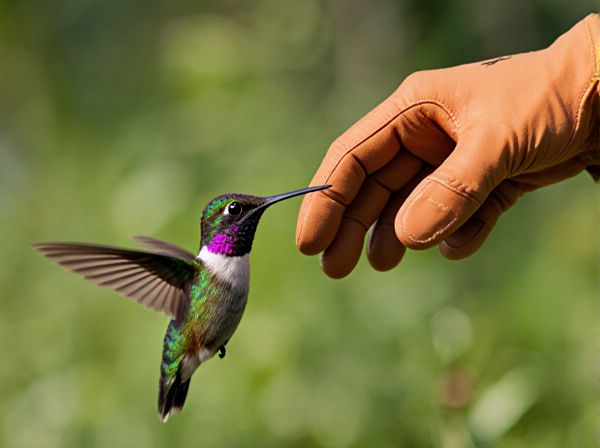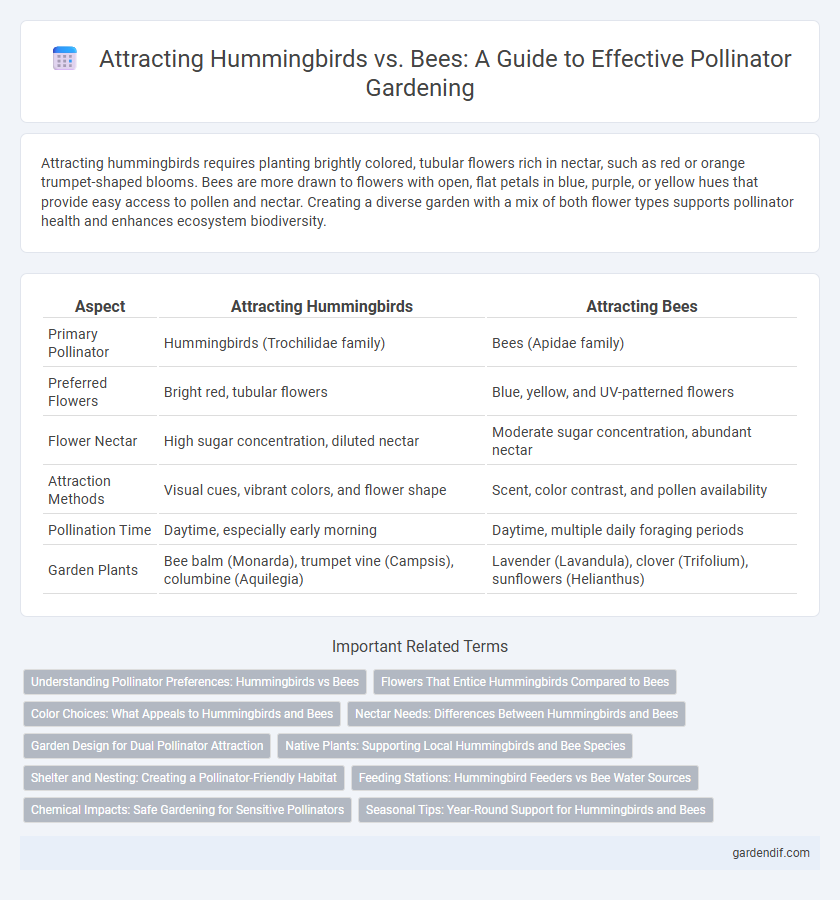
Attracting hummingbirds vs Attracting bees Illustration
Attracting hummingbirds requires planting brightly colored, tubular flowers rich in nectar, such as red or orange trumpet-shaped blooms. Bees are more drawn to flowers with open, flat petals in blue, purple, or yellow hues that provide easy access to pollen and nectar. Creating a diverse garden with a mix of both flower types supports pollinator health and enhances ecosystem biodiversity.
Table of Comparison
| Aspect | Attracting Hummingbirds | Attracting Bees |
|---|---|---|
| Primary Pollinator | Hummingbirds (Trochilidae family) | Bees (Apidae family) |
| Preferred Flowers | Bright red, tubular flowers | Blue, yellow, and UV-patterned flowers |
| Flower Nectar | High sugar concentration, diluted nectar | Moderate sugar concentration, abundant nectar |
| Attraction Methods | Visual cues, vibrant colors, and flower shape | Scent, color contrast, and pollen availability |
| Pollination Time | Daytime, especially early morning | Daytime, multiple daily foraging periods |
| Garden Plants | Bee balm (Monarda), trumpet vine (Campsis), columbine (Aquilegia) | Lavender (Lavandula), clover (Trifolium), sunflowers (Helianthus) |
Understanding Pollinator Preferences: Hummingbirds vs Bees
Hummingbirds are attracted to brightly colored, tubular flowers with high nectar content, preferring red, orange, and pink hues that accommodate their long beaks and hovering feeding style. Bees favor flowers with landing platforms, blue and yellow colors, and strong fragrances, utilizing their ability to detect ultraviolet patterns for efficient nectar and pollen collection. Understanding these distinct preferences enhances targeted garden planting strategies to support diverse pollinator populations effectively.
Flowers That Entice Hummingbirds Compared to Bees
Flowers that attract hummingbirds often feature tubular shapes and vibrant red or orange hues, providing easy access to nectar deep within their blossoms. In contrast, bee-attracting flowers typically present blue or yellow colors with wide landing platforms and abundant pollen. The difference in floral structure and color preference reflects the distinct feeding mechanisms and sensory adaptations of hummingbirds versus bees.
Color Choices: What Appeals to Hummingbirds and Bees
Hummingbirds are primarily attracted to bright red, orange, and pink flowers due to their strong color vision and preference for tubular shapes suited to their long beaks. Bees favor blue, violet, and yellow flowers, as they can see ultraviolet patterns that guide them to nectar sources. Selecting flower colors that match these preferences enhances pollination efficiency by targeting specific pollinators like hummingbirds and bees.
Nectar Needs: Differences Between Hummingbirds and Bees
Hummingbirds require high-energy, sugary nectar from tubular, brightly colored flowers, especially red and orange, to fuel their rapid metabolism and frequent feeding habits. Bees prefer nectar with a balanced sugar content and rely on flowers with accessible pollen and nectar, often favoring shades of blue, purple, and yellow that accommodate their visual spectrum. Understanding these nectar preferences is crucial for creating effective pollinator gardens that support the dietary needs of both hummingbirds and bees.
Garden Design for Dual Pollinator Attraction
In garden design aimed at dual pollinator attraction, selecting a diverse array of native flowering plants that produce both tubular flowers for hummingbirds and clustered blooms rich in pollen and nectar for bees is essential. Incorporating varying bloom times ensures continuous food sources, while strategically placing plants at different heights mimics natural habitats and facilitates access for both pollinators. Using vibrant reds and oranges draws hummingbirds, whereas blue and yellow flowers attract bees, optimizing the garden's ecological function and biodiversity.
Native Plants: Supporting Local Hummingbirds and Bee Species
Native plants play a crucial role in attracting local hummingbirds and bee species by providing the specific nectar sources and habitats these pollinators rely on. Tubular flowers like trumpet honeysuckle and bee balm cater to hummingbirds' long bills, while native wildflowers such as goldenrod and coneflowers support diverse native bee populations. Incorporating a variety of native plants ensures year-round forage and nesting opportunities, boosting the survival and health of both pollinator groups.
Shelter and Nesting: Creating a Pollinator-Friendly Habitat
Providing dense shrubs and protected areas with ample cover offers ideal shelter and nesting sites for hummingbirds, which prefer hanging nests in trees or shrubs. Bees, especially native solitary species, require bare ground or hollow stems for nesting, so incorporating open soil patches and plant debris supports their habitat needs. Designing diverse plant structures with varied heights enhances both hummingbird roosting and bee nesting opportunities in a pollinator-friendly garden.
Feeding Stations: Hummingbird Feeders vs Bee Water Sources
Hummingbird feeders designed with bright red colors and nectar solution attract hummingbirds effectively, providing a vital energy source for these pollinators. Bee water sources should consist of shallow dishes with pebbles or floating materials to prevent drowning while offering hydration for bees. Optimizing feeding stations by catering to the distinct needs of hummingbirds and bees enhances pollination success and supports biodiversity in gardens.
Chemical Impacts: Safe Gardening for Sensitive Pollinators
Choosing pollinator-friendly gardening practices minimizes chemical impacts harmful to sensitive species like hummingbirds and bees. Using organic pesticides and avoiding systemic insecticides helps protect their foraging behaviors and navigation abilities. Planting native flowers rich in nectar supports both hummingbirds and bees, ensuring a safe habitat free from toxic chemical exposure.
Seasonal Tips: Year-Round Support for Hummingbirds and Bees
Provide continuous blooms such as tubular red, orange, and pink flowers in spring through fall to attract hummingbirds, while planting diverse native wildflowers that bloom in early spring and late summer supports bee populations throughout the year. Incorporate water sources like shallow dishes for bees and misting areas for hummingbirds to ensure hydration during dry seasons. Plan staggered flowering schedules and diverse plant heights to maintain food availability and shelter, promoting year-round pollinator activity and ecosystem health.
Attracting hummingbirds vs Attracting bees Infographic

 gardendif.com
gardendif.com